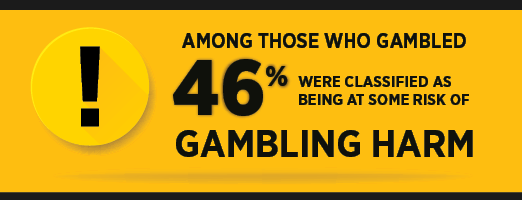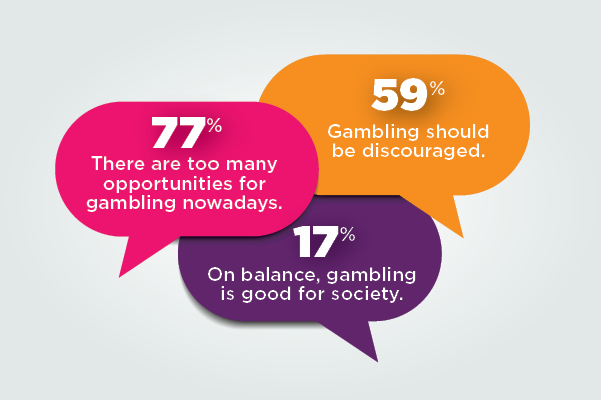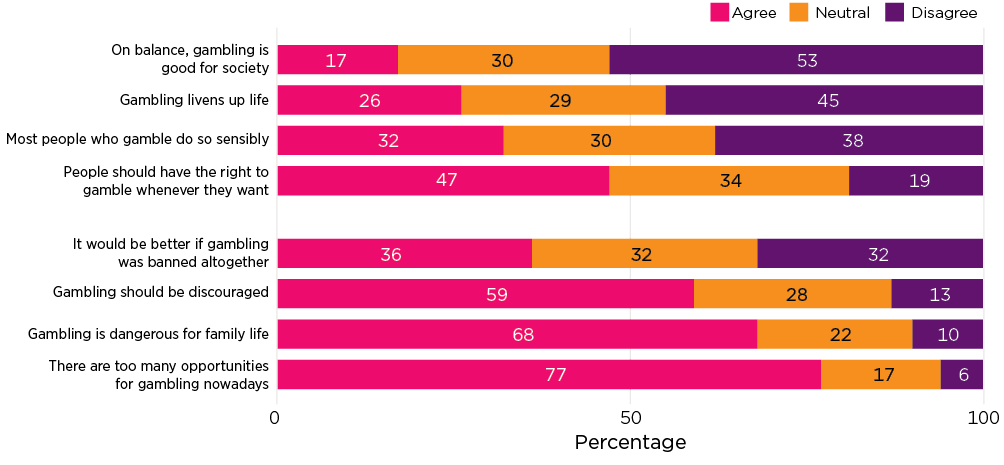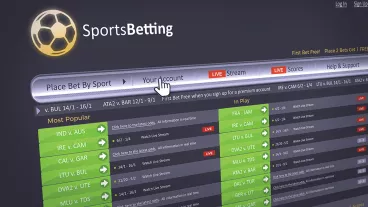Gambling participation and experience of harm in Australia
March 2023
Rebecca Jenkinson, Cailem Murray Boyle, Kei Sakata, Nancy Greer, Uma Jatkar, Brian Vandenberg
Download Research snapshot
Key messages
-
Survey findings show that around three-quarters (73%) of Australian adults gambled at least once in the past 12 months and almost two in five (38%) gambled at least weekly.
-
Among those who gambled, almost half (46%) were classified as being at some risk of gambling harm.
-
The most common products people spent money on were lotteries/scratchies (64%), horse racing (38%), sports betting (34%) and pokies (33%); most participants (70%) gambled on multiple products (two or more).
-
The average amount spent in a typical day when gambling was $83 (median = $20) on sports betting and $93 (median = $20) on race betting.
-
More men than women gambled on every product (e.g. sports, racing, pokies, lotteries, casino games). Men also gambled more often, spent more money and were more likely to be at risk of harm.
-
Most Australians expressed concern about the availability of gambling and its impacts on the community, believing that there are 'too many opportunities for gambling nowadays' (77%) and that gambling is 'dangerous for family life' (68%) and 'should be discouraged' (59%).
Gambling participation among Australian adults
Gambling participation by product and jurisdiction
Most Australian adults gambled at least once in the past 12 months (73%). The proportion of the population who spent money on gambling products (participation) varied by the type of product (activity) and state/territory. Lotteries/scratchies were the activity with the highest participation (64%), followed by race betting (including horse, greyhound and harness racing, 39%), sports betting (34%) and poker machines/'pokies' (33%).

Among those who reported gambling in the past 12 months, the average (median) number of products gambled on was two but around a quarter of respondents (23%) reported gambling on six or more different products.
We explored participation in race betting, sports betting and pokies (three higher risk activities) in more detail. Participation in all three activities was highest among survey respondents from New South Wales and lowest among those from Tasmania (Figure 1).
Figure 1: Percentage of population who gambled at least once in past 12 months on sports betting, race betting and pokies, by state

Notes: Territories (the ACT and NT) were excluded due to low sample size (n = 48). State only sample included (n = 1,717). Australian Bureau of Statistics (ABS) weights (age/gender) used for estimation.
Characteristics of people who gamble
Different groups in Australia reported different rates of gambling participation. Common factors associated with higher rates of participation in sports, racing and pokies included:
- being male
- younger age (18-34 years; except for horse racing where participants aged 55+ were equally as likely to bet as young people)
- being employed
- living with dependent children.
More men than women reported spending money on every type of gambling product included in the survey (including on products such as lotteries, keno and casino table games). The only product that older participants (aged 55+ years) were significantly more likely to spend money on than younger age groups was lotteries/scratchies.
Gambling frequency and expenditure
Around two in five adult Australians gambled at least weekly (38%), though this differed by gender (men: 48%, women: 28%). Average expenditure in a typical session among those who gambled was roughly similar for sports betting, race betting and other gambling products. Men reported spending more money gambling on all three product types compared to women (Table 1).
| Average expenditure (AUD) | |||
|---|---|---|---|
| Gambling product(s) | Overall | Men | Women |
| Sports (e.g. AFL, NRL) | $83 ($20) | $98 ($25) | $53 ($20) |
| Racing (including horse, greyhound and harness racing) | $93 ($20) | $112 ($30) | $63 ($20) |
| Any/all other gambling (e.g. poker machines, casino games, lotteries) | $109 ($30) | $119 ($30) | $92 ($30) |
Notes: Sports: n = 600; Racing: n = 687; Other: n = 713. Cut off at 99th percentile. ABS weights used for estimation.
Betting platforms
Almost half of Australian adults reported betting on sports and/or racing in the past year (44%). Sports bettors gambled on an average of 2.4 different sports, with AFL the most common (42%), followed by NRL (32%) and soccer (26%). Most sports and race betting was conducted online via a smart phone (42%) or a computer (22%). Participants who bet online had an average of two accounts; a fifth (19%) had three or more accounts.

Gambling harm among people who gamble
Among those who gambled, almost half (46%) were classified as being at some risk of gambling harm in the past 12 months (according to the Problem Gambling Severity Index1), with varying degrees of severity.

A greater proportion of men who gambled were at-risk of harm (men = 53%; women = 38%), and the proportion at risk decreased with age for both men and women. Young adults aged 18-34 were more than twice as likely to be at risk of harm compared to those aged 55 and older (Figure 2). Around two-thirds of all participants who gambled on sports (67%), racing (63%) and/or pokies (67%) were classified as being at risk of harm; the proportion was higher among people who gambled weekly or more often (sports = 74%, racing = 74%, pokies = 83%).
Figure 2: Proportion of Australian adults who gambled and were classified as being at risk of gambling harm (past 12 months)

Notes: Men (18-34 years: n = 221, 35-54 years: n = 232, 55+ years: n = 241); Women (18-34 years: n = 164, 35-54 years: n = 204, 55+ years: n = 220). ABS weights used for estimation.
Community attitudes towards gambling
A large majority of Australian adults believed that gambling is too prevalent in Australia. This was reflected in widespread agreement that 'there are too many opportunities for gambling nowadays' (77%) and 'gambling should be discouraged' (59%). Australians appeared to be divided on whether gambling should be banned altogether (36% agree, 32% disagree) but broadly agreed that 'people should have the right to gamble whenever they want' (47%). There was low agreement that 'on balance, gambling is good for society' (17%; Figure 3).

Figure 3: Attitudes towards gambling among Australian adults

Notes: Australian adults (n = 1,765). ABS weights used for estimation.
Our survey
An online general community panel survey was conducted in July 2022. A sample of 1,765 Australian residents aged 18 years and over, aligned with ABS population parameters of age, gender and location of residence (metro and non-metro), completed the survey. We explored participants' views on sports and race betting advertising by asking how much they agreed with a range of statements on a scale from 'strongly disagree' to 'strongly agree', and whether they 'supported' or 'opposed' a range of potential policy responses. As part of the survey, we also asked participants about their gambling participation in the past 12 months, including what products they gambled on, how much they spent, what platforms/modes they used to gamble, and how gambling impacted their health and wellbeing. We partnered with ORIMA Research and the Online Research Unit (ORU) to collect the survey data.
See all survey snapshots
- Gambling participation, experience of harm and community views
- Community attitudes towards sports and race betting advertising in Australia
- Exposure and impact of sports and race betting advertising in Australia
News stories
- Cut-off time: Support for banning gambling ads before 10.30pm| The Age
- Two thirds of Australians believe gambling ads are 'too common'| ABC News
- New Report Reveals Harmful Impact Of Gambling Ads| 10 News First Twitter
- Fresh Measures To Reduce Gambling Harm In Aussie Families| 10 News First Twitter
- Majority of Australians support banning gambling advertising on TV, study finds| The Guardian
- Young Australians being exposed to tsunami of powerful gambling ads, study reveals| 9News
- Support for ban on gambling ads| ABC News
- Most Australians support banning gambling ads: research| ABC News
- 'Destroying lives': Calls for action as survey finds two in five Australian adults gamble weekly| SBS News
- 'Money off misery': Crossbenchers demand Labor crack down on gambling ads, political donations| SBS News
- New research finds three-quarters of Australian adults have gambled at least once over the past 12 months| The West Australian
1 At-risk gambling during the past 12 months was assessed using the nine-item Problem Gambling Severity Index (PGSI). Respondents were grouped into four categories based on their scores: non-problem gambling (0), low-risk gambling (1-2), moderate-risk gambling (3-7) and problem gambling (8-27). Respondents scoring 1+ may be classified as being at some risk of, or already experiencing, gambling problems.
Contributions and acknowledgements
This research was conducted by the Australian Gambling Research Centre (AGRC) team at the Australian Institute of Family Studies: Dr Rebecca Jenkinson, Cailem Murray Boyle, Dr Kei Sakata, Nancy Greer, Uma Jatkar and Dr Brian Vandenberg.
Featured image: © GettyImages/welcomia
Suggested citation
Australian Gambling Research Centre. (2023). Gambling participation and experience of harm in Australia. Melbourne: Australian Gambling Research Centre, Australian Institute of Family Studies.
Download Research snapshot
Related publications

Gambling participation, experience of harm and community…
AGRC recently asked Australian adults about their participation in gambling, attitudes towards wagering advertising,…
Read more
Community attitudes towards sports and race betting…
Overall, this snapshot finds that 69% of Australian adults think that sports and race betting advertising is too common…
Read more
Exposure and impact of sports and race betting advertising…
This snapshot shows where and how often Australians are exposed to wagering advertising. It then explores the…
Read more